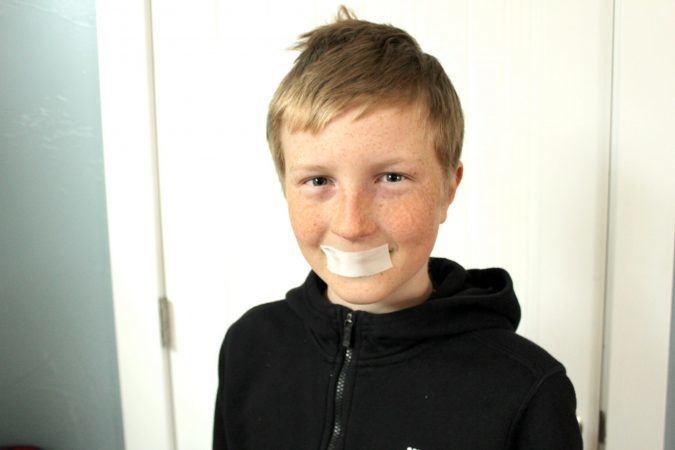What would you think if I told you that braces, asthma medication, decongestants, ADHD medications, and even CPAP machines could be replaced by a simple $2 roll of tape?
No, it’s not actually the tape that’s solving the problems, it’s just training you into the habit of nose breathing and out of the habit of mouth breathing.
Nose breathing is our natural way of breathing, with mouth breathing being part of our emergency ‘fight or flight’ system. Mouth breathing even triggers a fight or flight response on its own. Our modern culture contributes to the mouth breathing habit in a few ways.
First, our culture is higher stress than that of our ancestors, and stress triggers mouth breathing. Inversely, mouth breathing also triggers a stress response, creating a loop. Second, low-grade inflammation, chemical irritants, and mild allergies often result in chronic plugged noses. And the owners of these plugged noses often get in the habit of mouth breathing to get the air in.
Once again, your body, when encouraged to work properly through diet and lifestyle changes, is very capable. Little changes in our lifestyle add up to big changes in our overall health. In this case, it’s that we are too often breathing through our mouths, especially during sleep.
Mouths are for talking and eating, noses are for breathing
When we breathe in and out through our nose, we are using the normal pathway for air. Irritants are caught immediately in our nose. The air is warmed in our nose before hitting our lungs.
Different parts of the brain are oxygenated in different concentrations with nose breathing. In contrast, mouth breathing encourages the high-anxiety fight-or-flight response and alters brain chemistry. (source)
Tape to encourage nose breathing:
Somnifix is specially designed for mouth taping, and it may be a good way to introduce yourself to tape the mouth. But at around 50 cents/night for their specialty tape, most of us have chosen to use regular medical tape instead.
3M Micropore tape is widely recommended for its less-sticky adhesive that leaves little residue the next day. This tape works for many people, but some are allergic to the adhesive.
Hypoallergenic silk tape is what we ended up using due to an allergy to the adhesive on the micropore tape.
Other ways to encourage nose breathing:
Running a warm mist humidifier helps keep airways open.
Practicing nose breathing and closed mouth posture (tongue resting on the top of the mouth) during the day.
Mindfully practicing nose breathing during exercise.
Keeping stress low to keep the body out of fight or flight response.
Mouth breathing is associated with:
Cavities, due to dry mouth
Narrow palate, requiring braces and/or removal of teeth (source, source)
Change in facial development including a smaller chin (source)
Poor quality sleep (including thrashing, snoring, and waking up grumpy)
Attention deficit during the day (source)
Allergic rhinitis (source)
Thyroid and adrenal function, due to reduced nitric oxide (source)
Increased stress response including the fight/flight response (source)
Sensory processing issues, especially oral defensiveness
Learning disabilities, due to poor quality sleep and lack of nitric oxide in the brain (source)
Is more oxygen always better?
Just like food and water, it is possible to get too much oxygen to different parts of the brain. In the case of mouth breathing, it is shown that breathing through the mouth over oxygenates the prefrontal cortex, which causes a ‘fatigue’.
The prefrontal cortex, which also is one of the main parts of the brain affected by alcohol (source), is responsible for such things as self control, emotional regulation, personality, and delayed gratification (source).
Our results suggest that continued oxygen load on the prefrontal cortex from mouth breathing during the waking hours is one possible cause of ADHD arising from central fatigue.
Nasal breathing increases Nitric Oxide
Nitric oxide is a vasodilator that is produced at least 10% more when we breathe through our noses.
The discovery within the paranasal sinuses for the production of nitric oxide (NO) has altered the traditional explanations of sinus physiology… healthy paranasal sinus epithelium expresses an inducible NO synthase that continuously generates large amounts of NO, a pluripotent gaseous messenger with potent vasodilating, and antimicrobial activity. (source)
Nitric oxide is important for pulmonary (lung) function, and not having enough of it is associated with cardiac problems, increased cancer risk and cancer progression, poor wound healing, asthma, and more (source).
Continuous and regulated generation of NO is essential for the health of the cardiovascular system, immune and nervous system. Decreased production and/or bioavailability of NO is recognized as being one of the earliest events in the onset and progression of many diseases. – Nitric oxide enhancement strategies
This paper discusses the necessity of nitric oxide in pulmonary function and how those who are intubated miss out on this important compound.
Dental and Orthodontia problems
As Dr. Weston Price found, good oral health (avoiding cavities and having straight teeth) is much more of a holistic problem than just genetics, brushing, flossing, and needing braces.
Dr Mark Burhenne, DDS, talks about mouth taping, mouth breathing, and its effects on oral health in this podcast.
“Mouth breathing changes the hemodynamics of blood flow in your body and brain. It causes dry mouth which can lead to more cavities, bad breath, coated tongue, yellow tongue, or geographic tongue.
It can cause or aggravate gum disease, make you snore more and is involved in sleep apnea. If you are a mouth breather as a child, it changes how your face and airway develop and effects how you sleep for the rest of your life. Mouth breathing lessens the amount of nitric oxide that is created. It impacts the humidity of the lungs.”
From the High Intensity Health Podcast, click the link to read the rest of the show notes or listen.
Asthma
This study used a nasal dilator, not mouth tape, but showed that with nasal breathing episodes of nocturnal asthma was significantly reduced. The study showed decreased usage of asthma medication with nasal breathing as well.
This study, though, showed no improvement in asthma symptoms in the 50 patients that had active asthma.
Obstructive Sleep Apnea
Obstructive sleep apnea and snoring both can be helped by nose breathing rather than mouth breathing. This is due to both the increased nitric oxide and the lessened airway resistance with nose breathing in sleep. Both of those processes work together to help sleep apnea sufferers get a better night’s sleep.
This switch from nasal to oral breathing is disadvantageous physiologically and mouth breathing is associated with a reduction of the retropalatal and retroglossal areas and it lengthens the pharyngeal airway as a result of further posterior retraction of the tongue, which might result in elevation of Apnea Hypopnea Index (AHI) during sleep. (source)
This small study found, “Upper airway resistance during sleep and the propensity to obstructive sleep apnoea are significantly lower while breathing nasally rather than orally.”
This paper talks about the $5 device Nozovent, which manually opens the nose to encourage nose breathing, “It has also been shown to result in a decrease of the sleep apnoea index and improvement of arterial oxygen saturation during sleep apnoea.”
This small study of 30 people shows improvement with mouth taping in those with mild obstructive sleep apnea and open mouth breathing.
This study showed that humidifying the air encouraged nose-breathing and in turn reduced apenic episodes.
Interestingly, nasal surgery to encourage nose breathing through the removal or polyps or correction in those with obstructive sleep apnea has been explored, and the results have not been consistently helpful for sleep apnea, though they have helped with subjective ‘tiredness’ and snoring (source). To me it looks like encouraging nasal breathing by taping the mouth and humidifying the air are more sure-fire, and clearly less invasive, options for sleep apnea treatment.
Please remember: Sleep apnea is a serious condition and you should work closely with your doctor before modifying any of your treatments.
How to mouth tape for kids:
I have three different children with three different temperaments. This is how we tape their mouths to encourage nose breathing.
Tape to encourage nose breathing:
Somnifix is specially designed for mouth taping, and it may be a good way to introduce yourself to tape the mouth. But at around 50 cents/night for their specialty tape, most of us have chosen to use regular medical tape instead.
Hypoallergenic silk tape is what we ended up using due to an allergy to the adhesive on the micropore tape.
Encourage kids to DIY
My middle child, age 10, (up at the top, also my carnivore baby) gets a kick out of my health experiments and willingly does up his own mouth tape every night, and it’s still on every morning.
He seems to be in a better mood most mornings, but I haven’t seen any drastic difference with him.
Sneaky tape
My oldest, age 12, is my child that has special needs and thrashes around at night and sleeps with an open mouth more than the other two.
She does not like to go to sleep with tape on her mouth, but I can usually sneak in and stick one piece from top to bottom after she falls asleep but before I go to bed. While I quickly put the tape on, she briefly wakes up and rolls over without fussing. She does take the tape off sometime later (before morning), but I know she’s keeping it on for at least an hour, and she lays more still and I don’t hear snoring when she has it on.
I also will tape her mouth when she’s watching TV (like I do for my littlest) if I notice open-mouth posture. But for the most part she will self-correct to avoid the tape, which is ideal!
She gets dark circles with sleep deprivation, and these circles have seemed to lighten. Of note: Dark circles are also signs of an allergy (most commonly dairy). I do think that the mouth tape is helping her sleep quality improve.
Daytime Tape for Littles
My littlest is almost 5, but I don’t quite feel comfortable with his mouth being taped closed when I’m asleep. He has pretty good closed-mouth breathing when I check on him at night anyway, but to continue encouraging nose breathing I tape him for an hour or so at a time during the day. He doesn’t nap, so ‘quiet time’ or screen time is a good time for this.
Of all my children, my little is the most chatty, so using a movie helps encourage compliance- if the tape comes off, the movie goes off. I haven’t noticed anything specific with him, but I’d like to encourage the nose-breathing habit.
For adults:
To tape my mouth, I simply put a strip of tape on before going to bed. Using the minimum amount necessary to remind yourself to keep your mouth closed vs to seal the mouth can help avoid feeling claustrophobic.
Stories of Mouth Taping:
Just Take a Bite talks about taping her adorable daughter’s mouth, among other things to encourage nose breathing, to widen the palate, heal adrenals, reduce picky eating, and increase attention during the day.
Beverly Meyer, of On Diet and Health, tapes her mouth for deeper sleep, less snoring, for asthma and allergies, for a more calm mind and body, and to increase nitric oxide production.
Alex Fergus tapes his mouth closed for deeper sleep and to prevent dry mouth associated with mouth breathing.
Sources:
The post Mouth Taping for Good Health in Kids and Adults appeared first on Health, Home, & Happiness.
Read more: healthhomeandhappiness.com








